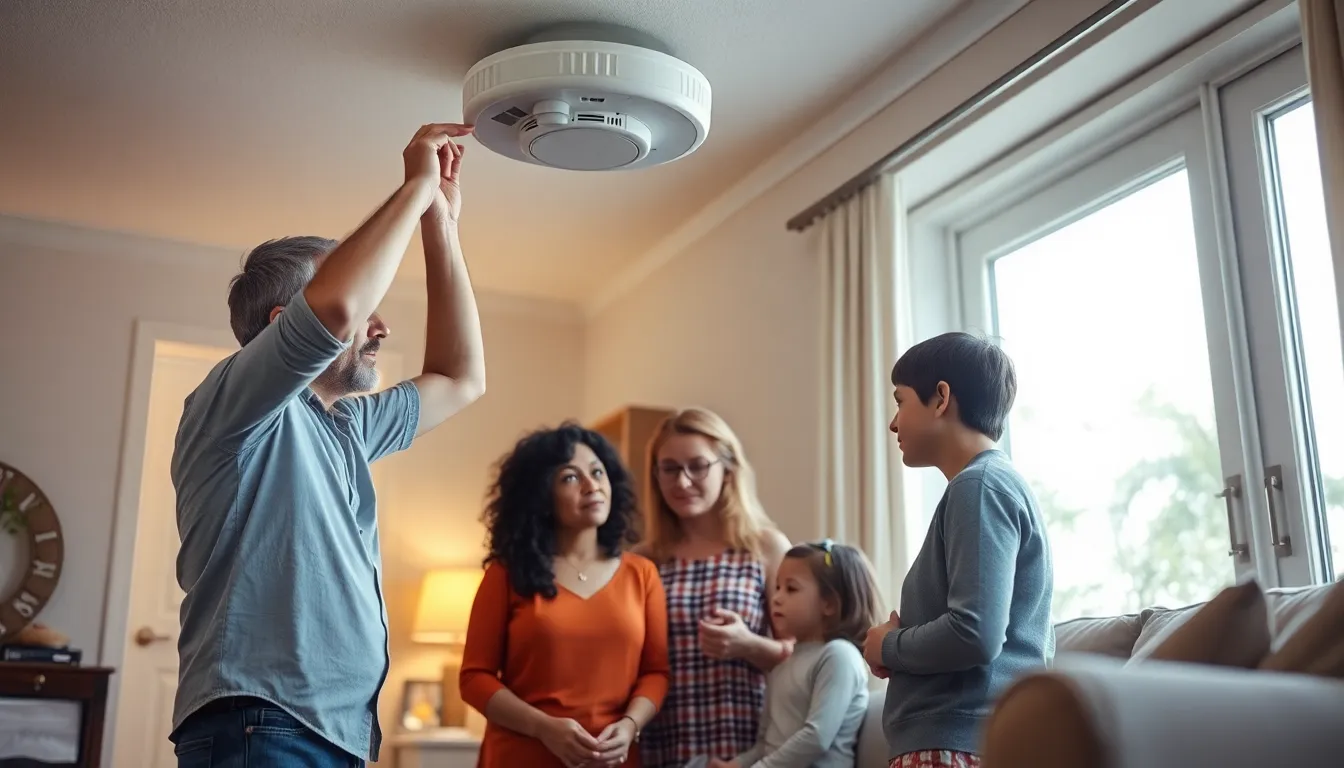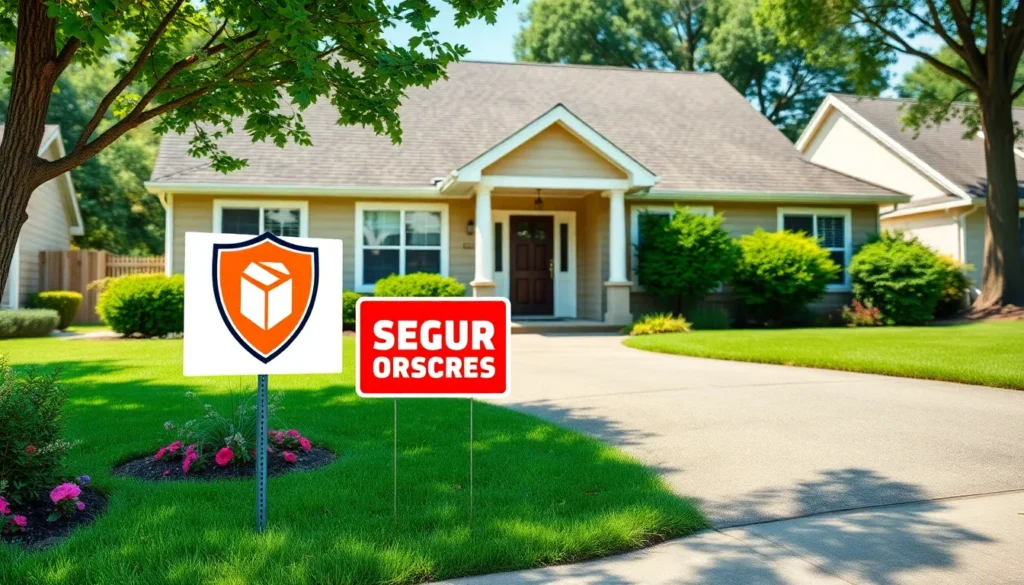Home is where comfort and security should reign, yet many overlook essential safety measures that protect loved ones and property. With increasing concerns about burglary, fire hazards, and accidents, ensuring a safe living environment has never been more crucial.
Implementing effective home safety measures can significantly reduce risks and provide peace of mind. From simple adjustments like securing doors and windows to investing in advanced security systems, every step counts. This article will explore practical strategies to enhance home safety, making it a sanctuary for everyone inside.
Table of Contents
ToggleUnderstanding Home Safety Measures
Home safety measures encompass a variety of strategies designed to protect occupants and property. These measures address potential risks like burglary, fire, and accidents, greatly enhancing the overall security of a residence.
1. Securing Entry Points
Securing entry points forms the foundation of home safety.
- Locks: High-quality deadbolts secure doors against forced entry.
- Windows: Window locks prevent unauthorized access and are vital for upper-level security.
- Doors: Reinforced doors resist break-ins, adding an extra layer of protection.
2. Installing Security Systems
Installing security systems provides real-time surveillance and alerts.
- Cameras: Security cameras deter intruders and offer visual evidence in case of incidents.
- Alarms: Alarm systems notify homeowners and authorities of unauthorized entries, ensuring quick responses.
- Smart Technology: Smart home devices allow remote control of security features, enhancing user convenience.
3. Fire Prevention Strategies
Fire prevention strategies greatly reduce the risk of house fires.
- Smoke Detectors: Installing smoke detectors in every room ensures early detection of fire hazards.
- Fire Extinguishers: Keeping fire extinguishers readily available allows for immediate action against small fires.
- Escape Routes: Establishing clear escape routes and practicing emergency drills prepare residents for fire emergencies.
4. Child and Pet Safety
Child and pet safety measures protect vulnerable household members.
- Safety Gates: Installing safety gates restricts access to hazardous areas, such as stairs and kitchens.
- Cabinet Locks: Cabinet locks deter children and pets from accessing harmful substances.
- Furniture Anchoring: Anchoring furniture prevents tipping, reducing the risk of injury.
5. Outdoor Safety Measures
Outdoor safety measures ensure that external environments remain secure.
- Lighting: Installing motion-sensor lights around the property enhances visibility and deters intruders.
- Fencing: Secure fencing protects yards from unwanted visitors, increasing overall safety.
- Landscaping: Maintaining shrubs and trees minimizes hiding spots for potential intruders and improves sightlines.
By adopting these home safety measures, individuals protect their residences from a variety of risks, promoting a secure living environment.
Importance of Home Safety

Home safety measures play a crucial role in protecting individuals and families from various threats. By implementing effective strategies, residents can safeguard their homes and provide a secure environment.
Reducing Risks
Reducing risks involves identifying and addressing potential hazards within the home. Homeowners can achieve this by:
- Securing Entry Points: Install high-quality locks on doors and windows to deter unauthorized access. Consider deadbolts and window locks for added security.
- Installing Security Systems: Use alarm systems and surveillance cameras to monitor activity around the property. Real-time alerts can help respond quickly to suspicious activities.
- Implementing Fire Prevention Measures: Equip homes with smoke detectors and fire extinguishers at strategic locations. Regularly test smoke detectors and replace batteries annually to ensure functionality.
- Addressing Child and Pet Safety: Use safety gates to restrict access to dangerous areas. Install cabinet locks to prevent children and pets from accessing harmful substances.
- Enhancing Outdoor Safety: Install motion-sensor lighting to illuminate dark areas around the home. Secure fences can deter intruders and provide a safe play environment for children and pets.
Enhancing Peace of Mind
Enhancing peace of mind involves creating a sense of security for residents. Strategies include:
- Regular Safety Drills: Conduct fire drills and emergency escape plans with all household members. Familiarity with protocols can reduce panic during actual emergencies.
- Community Involvement: Join neighborhood watch programs to increase awareness of local safety issues. Engaging with neighbors can foster a sense of community support.
- Routine Maintenance Checks: Perform regular inspections of smoke detectors, security systems, and locks to ensure all safety measures function properly. Timely maintenance reduces vulnerabilities.
- Educating Family Members: Teach all residents about safety protocols, including whom to contact in emergencies. Knowledge empowers everyone to respond effectively to threats.
Implementing these measures not only protects property and individuals from harm but also fosters a more secure living environment.
Common Home Safety Hazards
Identifying common home safety hazards is crucial for creating a secure living environment. Many dangers lurk within and around the home, posing various risks to residents.
Fire Hazards
Fire hazards encompass various sources that can lead to dangerous situations. Examples include:
- Overloaded electrical outlets: Plugging multiple devices into one outlet can cause overheating and potential fires.
- Flammable materials: Items like paper, cloth, and chemicals stored near heat sources increase fire risks.
- Neglected appliances: Failing to maintain stoves, heaters, and dryers can lead to malfunctions and fire outbreaks.
- Unattended cooking: Leaving cooking food unattended significantly increases odds of kitchen fires.
Regularly inspecting these hazards and taking preventive measures, such as installing smoke detectors and fire extinguishers, enhances safety.
Security Threats
Security threats pose significant risks that affect the safety of residents and their belongings. Key aspects include:
- Inadequate locks: Weak or damaged locks on doors and windows offer easy access to intruders.
- Poor outdoor lighting: Insufficient illumination around entry points can create hiding spots for burglars.
- Unsecured entrances: Leaving doors ajar or windows open invites unauthorized entry.
- Lack of surveillance: Absence of security cameras or alarm systems decreases awareness of suspicious activity.
Implementing strong locks and robust surveillance systems reduces security threats, ensuring a safer home environment.
Fall Risks
Fall risks frequently lead to injuries, particularly among children and the elderly. Common fall hazards include:
- Cluttered walkways: Items obstructing pathways can lead to trips and falls.
- Loose rugs or carpets: Rugs without non-slip backing can slip, increasing fall chances.
- Unsafe stairways: Missing handrails or poorly lit stairs elevate the risk of accidents.
- Wet surfaces: Spills or wet floors can create dangerous situations.
Addressing these issues through proper organization and maintenance promotes a safer home and reduces fall-related incidents.
Effective Home Safety Measures
Home safety measures encompass essential strategies to protect against various risks, including fire hazards, security threats, and fall injuries. Implementing these measures enhances the well-being of all residents.
Fire Safety Protocols
Install smoke detectors in every room and test them monthly. Keep fire extinguishers readily accessible, particularly in the kitchen and near heat sources. Create a fire escape plan, ensuring all family members are familiar with exit routes and designated meeting spots. Reduce fire risks by regularly inspecting electrical outlets for damage and avoiding overloads. Maintain clear access to extinguishers and exits by regularly decluttering spaces.
Security Systems and Measures
Utilize high-quality locks for all doors and windows to deter break-ins. Install security cameras and alarm systems for real-time alerts and surveillance. Integrate smart home technology for remote monitoring and alert notifications. Employ outdoor lighting with motion sensors to illuminate entrances and deter intruders. Join community programs, like neighborhood watch, to increase vigilance and share information about local security concerns.
Fall Prevention Techniques
Identify and remove clutter from walkways to minimize tripping hazards. Secure loose rugs with non-slip backing or remove them altogether. Install handrails on stairways and ensure adequate lighting in these areas. Use non-slip mats in bathrooms and kitchens to prevent falls on wet surfaces. Educate family members about safe practices, especially for young children and elderly individuals, to avoid accidents.
Tips for Maintaining Home Safety
- Install quality locks: Use deadbolts and smart locks on all doors. Invest in window locks for added security.
- Implement security systems: Set up alarm systems and surveillance cameras. Choose systems with remote monitoring capabilities.
- Conduct fire drills: Regularly practice fire escape plans with all family members. Ensure everyone knows the exit routes and meeting points.
- Check smoke detectors: Test smoke detectors monthly and replace batteries biannually. Install detectors on each level of the home.
- Keep fire extinguishers accessible: Place extinguishers in key areas, such as the kitchen and garage. Ensure everyone knows how to use them.
- Remove trip hazards: Maintain clear walkways by removing clutter. Secure area rugs and use non-slip mats in slippery areas.
- Trim outdoor vegetation: Regularly cut back shrubs and trees that obstruct visibility. Maintain lighting around the perimeter to enhance outdoor safety.
- Educate family on safety protocols: Teach household members about emergency contacts and procedures. Discuss how to respond to various types of emergencies.
- Join neighborhood watch programs: Participate in community safety initiatives. Build relationships with neighbors for increased vigilance.
- Schedule routine maintenance: Inspect locks, alarms, and smoke detectors regularly. Address any wear or issues promptly to maintain safety standards.
Prioritizing home safety is essential for protecting both loved ones and property. By implementing the recommended measures individuals can significantly reduce risks and enhance their peace of mind. Regular maintenance checks and community involvement further strengthen safety efforts.
Taking proactive steps today leads to a safer tomorrow. Whether it’s installing security systems or educating family members about emergency protocols every action contributes to a secure environment. With vigilance and preparedness home safety can become a shared responsibility that fosters a sense of security for everyone.


